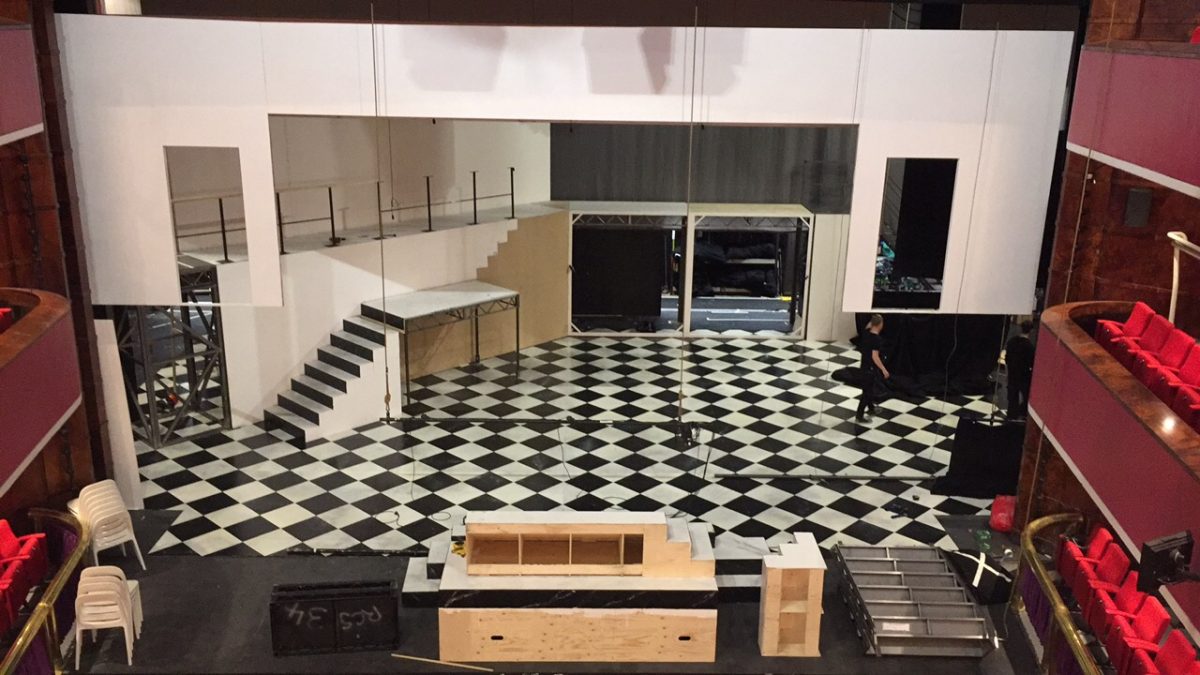In an effort to fill the first two weeks of what was meant to be my CPP allocation – though, as it turned out, there was nothing to prep for those particular shows – I decided to ask if I could help the Opera team with their rig. This served the double purpose of helping me become more familiar with rigging the Ath stage – something I hadn’t done before – and preventing myself from becoming too bored after what had already felt like two weeks of dead air. As it turned out, this was a great decision, as I ended up learning so much in that two week block, some of which made the allocation in the Chandler which followed a lot easier to manage.
It began with a conversation with Ben, the TSM, in the production office. Here, he spoke to me about how he was going to go about assembling the stage, showing me Vectorworks plans and hand drawn sketches to explain his ideas. It was really nice to see someone who clearly cared so much about what they were doing – a trait I could defin
It began with a conversation with Ben, the TSM, in the production office. Here, he spoke to me about how he was going to go about assembling the stage, showing me Vectorworks plans and hand drawn sketches to explain his ideas. It was really nice to see someone who clearly cared so much about what they were doing – a trait I could defin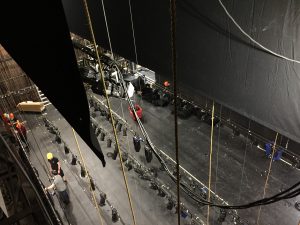 itely
itely
see myself trying to emulate. When we actually got onto the stage for the markup, however, it became clear that the digital plan was a clusterfuck, with different designers working in different ways to create a file that was incredibly hard to navigate and work with. To give an example, when the ‘grid’ was turned off, half the stalls seating was removed from the viewport. As such, this slowed down the first day of the process, as we were unable to work from an accurate, to scale, ground plan, meaning that some points had to be marked two or three times. This was scarily similar to the ‘Chess’ V4 situation, and shows the need for care and attention when so many people are working on such an important document.
As we started dropping in points I ended up on the grid with Heather. My time in the air was invaluable as the constant repetition of the work we were doing drummed in the practice to me, to the point where I was working quickly and correctly for each point we put in. By using my previous knowledge of knots and hemp work, I could correctly tie stoppers and plugs to prevent ropes slipping, and could cleat off to the fly floors to prevent rope runs. Heather also showed me how to properly coil a rope for the first time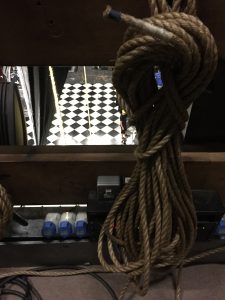 , something I’ve struggled with since our stage induction in September. But the simple way she showed, and the fact that I then went on to do it dozens of times, drilled the process into me to the point where I could do it without looking. Learning how to do this process to hang on cleats as well was great, as it meant I could take charge of tidying the prompt side fly floor, running lines as straight as I could make them and trying up the excess to aide flyman Reece. I could also remove our lines from a floor that was becoming more and more covered in the cable mountain monstrosity of the electrical department. To be taught like this by a peer was a really nice experience, as the slight fear factor in messing up was removed, and I could feel more at ease to ask questions and to make mistakes. This is definitely a way of working that I would be looking to promote and take part in with those in the years that will follow me, as it also helps to reinforce my own learning by teaching others – a mantra Malcy always pushes.
, something I’ve struggled with since our stage induction in September. But the simple way she showed, and the fact that I then went on to do it dozens of times, drilled the process into me to the point where I could do it without looking. Learning how to do this process to hang on cleats as well was great, as it meant I could take charge of tidying the prompt side fly floor, running lines as straight as I could make them and trying up the excess to aide flyman Reece. I could also remove our lines from a floor that was becoming more and more covered in the cable mountain monstrosity of the electrical department. To be taught like this by a peer was a really nice experience, as the slight fear factor in messing up was removed, and I could feel more at ease to ask questions and to make mistakes. This is definitely a way of working that I would be looking to promote and take part in with those in the years that will follow me, as it also helps to reinforce my own learning by teaching others – a mantra Malcy always pushes.
Speaking of Malcy, when I wasn’t on the grid or on flys I mainly shadowed him, trying to soak up as much information as I could from how he worked in a production setting. This was amazing as, each time I would make a mistake, he would be willing to take time to show me how to do it properly so my error would not happen again. This was best exhibited in the two separate occasions when I had tied a knot and it had snapped when unde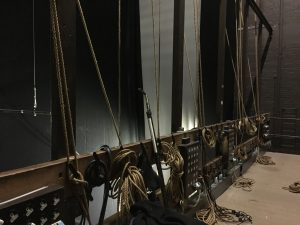 r pressure. Though we had been shown earlier in the year that the best way of joining two lines with a sheet bend, Malcy detailed why, in many instances, this wasn’t the case, and taught me how to tie a Fisherman’s properly – a knot that it still pleases me every time I pull it off. This, along with the barrel knot and a proper figure of eight on the bite are possibly the most valuable things I have taken out of my opera experience, as they went on to be invaluable additions to my skillset when rigging in the Chandler, and have ignited my desire to add more and more knots to my arsenal – something I intend to start working with Yesha on at great lengths.
r pressure. Though we had been shown earlier in the year that the best way of joining two lines with a sheet bend, Malcy detailed why, in many instances, this wasn’t the case, and taught me how to tie a Fisherman’s properly – a knot that it still pleases me every time I pull it off. This, along with the barrel knot and a proper figure of eight on the bite are possibly the most valuable things I have taken out of my opera experience, as they went on to be invaluable additions to my skillset when rigging in the Chandler, and have ignited my desire to add more and more knots to my arsenal – something I intend to start working with Yesha on at great lengths.
What Opera has also taught me is the importance of an accurate plan. In the end, we moved the automation points on the grid around five times before they ended up in the correct position. This was due to the piece they were attached to not being able to fly past everything else in the air. I am tempted to believe that had this been drawn in 3D from the start, the points could have been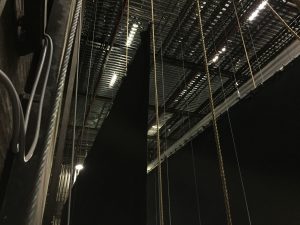 a lot more precise and would only have had to have been installed once. The automation system in the Ath is a pain, and the fewer times you have to move points, the better it is for your continued mental stability. This shows the importance of having a good grasp of Vectorworks and plan drawing, something I will continue to work towards as I advance into more senior roles. Also, though someone will likely later correct me, changing out the drift ends for Reutlingers would make me so happy. Just a thought.
a lot more precise and would only have had to have been installed once. The automation system in the Ath is a pain, and the fewer times you have to move points, the better it is for your continued mental stability. This shows the importance of having a good grasp of Vectorworks and plan drawing, something I will continue to work towards as I advance into more senior roles. Also, though someone will likely later correct me, changing out the drift ends for Reutlingers would make me so happy. Just a thought.
Overall, Opera was amazingly beneficial to me, not only in what I learnt, but by being in a supportive environment as I did it. To work for an HOD who was willing to let me go and work on ways of doing things like pegging braces to flats or stropping and flying steel deck platforms by myself without instruction from him – after I had proved that I knew what I was doing – was refreshing, and made me feel like a trusted member of a team. This gave me belief in my own ability as well, a self-confidence boost that I was thankful to have. Moving on from this, I would aim to create this positive working environment for my crews and for my peers when they work with me, as it pushed us to prove to Barry and ourselves that we were as good as we said we were. I strive to be an HOD who believes in their teams ability, rather than one who would try to trying to push them back down. It has also further reaffirmed for me the importance of planning, and the pitfalls that can arise when things are jumped into without the proper forethought.
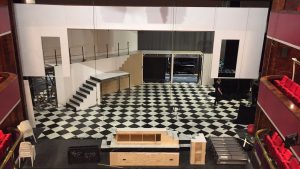
The Stage, as I left it.
SaveSave

